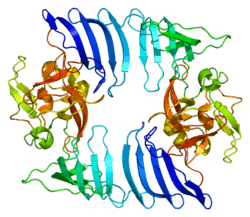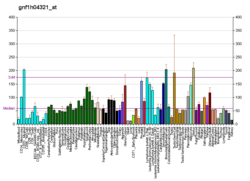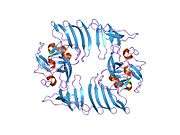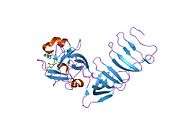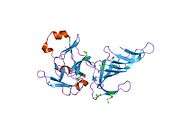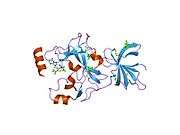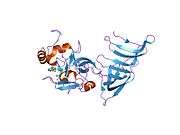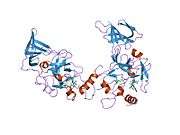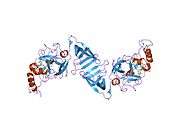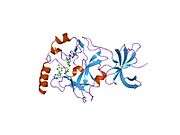SETD7
Histone-lysine N-methyltransferase SETD7 is an enzyme that in humans is encoded by the SETD7 gene.[5][6][7]
References
- 1 2 3 GRCh38: Ensembl release 89: ENSG00000145391 - Ensembl, May 2017
- 1 2 3 GRCm38: Ensembl release 89: ENSMUSG00000037111 - Ensembl, May 2017
- ↑ "Human PubMed Reference:".
- ↑ "Mouse PubMed Reference:".
- ↑ Nishioka K, Chuikov S, Sarma K, Erdjument-Bromage H, Allis CD, Tempst P, Reinberg D (Feb 2002). "Set9, a novel histone H3 methyltransferase that facilitates transcription by precluding histone tail modifications required for heterochromatin formation". Genes Dev. 16 (4): 479–89. doi:10.1101/gad.967202. PMC 155346. PMID 11850410.
- ↑ Wang H, Cao R, Xia L, Erdjument-Bromage H, Borchers C, Tempst P, Zhang Y (Jan 2002). "Purification and functional characterization of a histone H3-lysine 4-specific methyltransferase". Mol Cell. 8 (6): 1207–17. doi:10.1016/S1097-2765(01)00405-1. PMID 11779497.
- ↑ "Entrez Gene: SETD7 SET domain containing (lysine methyltransferase) 7".
Further reading
- Nagase T, Kikuno R, Hattori A, et al. (2001). "Prediction of the coding sequences of unidentified human genes. XIX. The complete sequences of 100 new cDNA clones from brain which code for large proteins in vitro". DNA Res. 7 (6): 347–55. doi:10.1093/dnares/7.6.347. PMID 11214970.
- Wilson JR, Jing C, Walker PA, et al. (2002). "Crystal structure and functional analysis of the histone methyltransferase SET7/9". Cell. 111 (1): 105–15. doi:10.1016/S0092-8674(02)00964-9. PMID 12372304.
- Jacobs SA, Harp JM, Devarakonda S, et al. (2002). "The active site of the SET domain is constructed on a knot". Nat. Struct. Biol. 9 (11): 833–8. doi:10.1038/nsb861. PMID 12389038.
- Strausberg RL, Feingold EA, Grouse LH, et al. (2003). "Generation and initial analysis of more than 15,000 full-length human and mouse cDNA sequences". Proc. Natl. Acad. Sci. U.S.A. 99 (26): 16899–903. doi:10.1073/pnas.242603899. PMC 139241. PMID 12477932.
- Kwon T, Chang JH, Kwak E, et al. (2003). "Mechanism of histone lysine methyl transfer revealed by the structure of SET7/9–AdoMet". EMBO J. 22 (2): 292–303. doi:10.1093/emboj/cdg025. PMC 140100. PMID 12514135.
- Xiao B, Jing C, Wilson JR, et al. (2003). "Structure and catalytic mechanism of the human histone methyltransferase SET7/9". Nature. 421 (6923): 652–6. doi:10.1038/nature01378. PMID 12540855.
- Wysocka J, Myers MP, Laherty CD, et al. (2003). "Human Sin3 deacetylase and trithorax-related Set1/Ash2 histone H3-K4 methyltransferase are tethered together selectively by the cell-proliferation factor HCF-1". Genes Dev. 17 (7): 896–911. doi:10.1101/gad.252103. PMC 196026. PMID 12670868.
- Kouskouti A, Scheer E, Staub A, et al. (2004). "Gene-specific modulation of TAF10 function by SET9-mediated methylation". Mol. Cell. 14 (2): 175–82. doi:10.1016/S1097-2765(04)00182-0. PMID 15099517.
- Gerhard DS, Wagner L, Feingold EA, et al. (2004). "The Status, Quality, and Expansion of the NIH Full-Length cDNA Project: The Mammalian Gene Collection (MGC)". Genome Res. 14 (10B): 2121–7. doi:10.1101/gr.2596504. PMC 528928. PMID 15489334.
- Chuikov S, Kurash JK, Wilson JR, et al. (2004). "Regulation of p53 activity through lysine methylation". Nature. 432 (7015): 353–60. doi:10.1038/nature03117. PMID 15525938.
- Couture JF, Collazo E, Hauk G, Trievel RC (2006). "Structural basis for the methylation site specificity of SET7/9". Nat. Struct. Mol. Biol. 13 (2): 140–6. doi:10.1038/nsmb1045. PMID 16415881.
- Hayakawa T, Ohtani Y, Hayakawa N, et al. (2007). "RBP2 is an MRG15 complex component and down-regulates intragenic histone H3 lysine 4 methylation". Genes Cells. 12 (6): 811–26. doi:10.1111/j.1365-2443.2007.01089.x. PMID 17573780.
This article is issued from
Wikipedia.
The text is licensed under Creative Commons - Attribution - Sharealike.
Additional terms may apply for the media files.
